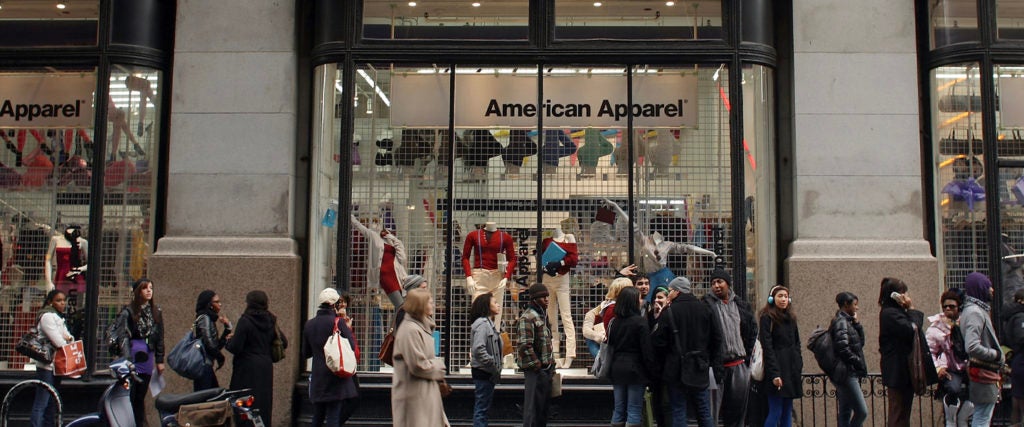Just last weekend, I sorted through a box of clothes I’d left at my mother’s house. Inside, I found an absolute gem of an outfit: a cropped, three-quarter sleeve wrap top, a pair of white-trimmed interlock “running” shorts and a set of knit leg warmers, all purchased from American Apparel at the tail end of the Dov Charney era.
I could flip each of these items on Depop today and easily make back their original value, but I wouldn’t dream of it. More than anything, I fantasize of being photographed on a Polaroid camera with the flash on while wearing them, or maybe in a bodysuit and thigh-high socks. After all, the American Apparel indie-sleaze aesthetic is back, and some are even wondering if it’s the new Y2K.
It was only a matter of time before metallic leotards and weird Grecian goddess headbands returned from the dead. The last two years have been dominated by nostalgia for the early aughts — baby pink flip phones, velour tracksuits, anything reminiscent of Paris Hilton circa The Simple Life. But as the rapidly shifting trend cycle demands, we must find a new era to thirst after, and that era is now the late 2000s and early 2010s.
This was the treasured era of history during which American Apparel reigned supreme. The brand, however, wasn’t without problems. A major cause for the downfall of its aesthetic was the downfall of the company itself — in 2014, after years of overly provocative, not-even-close-to-subtle, sexually suggestive advertising, the brand’s original owner, the aforementioned Charney, was hit with numerous sexual assault allegations and was forced out. Meanwhile, photographer Terry Richardson, who shot many of the brand’s ads and was a key figure in developing the snapshot, instant-camera look of the period, had been accused of sexually exploiting models since 2001. Tarnished by the disturbing behavior of its leaders, American Apparel officially shut down in 2017, though a version of the brand (under the Gildan umbrella) continues to exist on Amazon. Since then, Charney has resurfaced with the launch of Los Angeles Apparel, an identical twin to American Apparel, only with shittier products and a more regional name.
Controversy aside, there are undeniable strengths to this hipster aesthetic that makes it easy to revitalize today. Part of its appeal is that while it’s thoroughly hitched to the past, its components are both classic and nearly brandless. American Apparel’s items were themselves originally mirrored upon 1980s/1990s athletic wear with a few added disco influences, something that’s become popular again and is primarily promoted as “basics.” After all, there’s nothing really new about V-neck T-shirts, tennis skirts and tube socks.
But what worked about American Apparel is that it often exaggerated a minor detail of these basics — their deep V-necks were parody-level deep, their tennis skirts were modeled to be pornographically short and their tube socks were designed to hit the thigh at a place where they looked more like lingerie than something you’d work out in. Still, even as the American Apparel trend initially faded, these items remained basic (and frankly, cute and well-made) enough that many of us held onto them.
As TikTok trend forecaster @oldloserinbrooklyn explained in two videos last week, indie sleaze was also characterized by party photographers like The Cobra Snake. Part of the appeal of party photography wasn’t just the look that it delivered, but what it represented. The Cobra Snake’s style was casual debauchery — he’s photographing a party, yes, but everyone’s in T-shirts and hoodies, their eyeliner is smeared and the flash of the camera captures each moment with honesty. The photos would end up online, but not till the party was over. There was no posing 100 different ways until you got the perfect Instagrammable picture. Even if entirely contrived, it at least looked like everyone was in the moment.
To be nostalgic for this, then, is to be nostalgic for a time when things seemed just a little bit easier. We were all still online, to be sure, but neither Myspace nor Tumblr felt like such cloying dictators of our social lives. We’re nostalgic for the ease of American Apparel dressing, too — understated, yet sexy, with the store offering a one-stop shop for a versatile hipster uniform.
Surely, some of the more obnoxious elements of the era will soon be revived with it, like neon shutter shades, Ke$ha-style glitter and maybe even an obsession with mustaches. For now, though, I can’t complain that my decision to hold onto the simple, flattering clothes from American Apparel has paid off. I can only hope that party photography — or more specifically, phoneless, non-Instagrammed party photography — returns with it. I mean, everyone looks good photographed in a ringer tee with the flash on.

